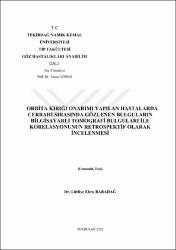| dc.contributor.advisor | Gönen, Tansu | |
| dc.contributor.author | Babadağ, Lütfiye Ebru | |
| dc.date.accessioned | 2023-04-27T20:41:19Z | |
| dc.date.available | 2023-04-27T20:41:19Z | |
| dc.date.issued | 2022 | |
| dc.identifier.uri | https://tez.yok.gov.tr/UlusalTezMerkezi/TezGoster?key=qVqOZFj2DwNmvdf1oGFYiDABhIcoCX9LsM4MfVGYRX01_DIQVqM2HtNFkrXSuvCd | |
| dc.identifier.uri | https://hdl.handle.net/20.500.11776/11720 | |
| dc.description.abstract | Günümüzde yüz travmalarını takiben globu çevreleyen orbita kemiklerinde kırık izlenmesi karşımıza sıklıkla çıkan klinik tablolardandır. Orbita fraktürleri travmanın şiddetine bağlı olarak görme kaybı, glob rüptürü, diplopi, göz hareket kısıtlılığı gibi işlevsel hasarlara ilaveten enoftalmus, distopi gibi kozmetik sorunlara da yol açabilir. Orbita kırıklarının radyolojik değerlendirmesinde altın standart yöntem Bilgisayarlı Tomografi (BT)'dir. Bu çalışmada orbital kırık onarımı yapılan hastalarda cerrahi işlem sırasında elde edilen verilerle BT görüntüleri arasındaki korelasyonun incelenmesi amaçlanmıştır. Araştırmanın ikincil amacı ise orbital kırık izlenen hastaların epidemiyolojisinin yanı sıra ek patolojilerin ve cerrahi gereksinimlerin incelenmesidir. Yetmiş bir hastanın 73 orbitasına ilişkin demografik ve klinik verilerinin yanı sıra 47 hastanın 48 orbitasının cerrahi bulguları ve BT görüntüleri arasındaki ilişki analiz edilmiştir. Orbital kırık cerrahi bulguları ile radyolojik veriler kıyaslandığında kırık bölgesine göre en fazla uyum orbita taban ve dış duvarda (% 91,7) saptandı. Kırılan kemik açısından ise uyum oranı en çok (% 95,8) zigomatik kemik ve orbita dışı kraniyal kemikte bulundu. Lakrimal kemikte ise korelasyon gözlenmedi (p=0,064). Cerrahi işlem sırasında 73 orbitanın 72'sinde (% 98,6) porlu polietilen implant kullanıldı. Orbital kemiklerde fiksasyon en sık dış duvarda yapıldı. Yetmiş üç orbitada cerrahi işlem yolu en sık inferior transkonjonktival yoldu (n=52). Orbital cerrahiye ilaveten en sık tam kat kapak kesisi onarımı (% 9,6) uygulandı. Bu sonuçlar bize orbita tabanında ve dış duvarında izlenen radyolojik bulguların iç duvara göre daha yol gösterici olduğunu düşündürmüştür. Orbita kırığını saptamak ve onarım için karar verebilmek amacıyla bilgisayarlı tomografi ile görüntüleme vazgeçilmezdir. Sonuç olarak gelişen teknolojiyle beraber bilgisayarlı tomografi bulgularının detaylı değerlendirilmesi klinisyene yol gösterici olacaktır. | en_US |
| dc.description.abstract | Today, fractures of the orbital bones surrounding the globe following facial trauma are among the most common clinical presentations. Depending on the severity of the trauma, orbital fractures may cause functional damage such as vision loss, globe rupture, diplopia, eye movement restriction and cosmetic problems such as enophthalmos and dystopia. The gold standard method for radiologic evaluation of orbital fractures is Computed Tomography (CT). The aim of this study was to investigate the correlation between the data obtained during the surgical operation and CT findings in patients undergoing orbital fracture repair. The secondary aim of the study was to investigate the epidemiology of patients with orbital fractures as well as additional pathologies and surgical requirements. The demographic and clinical data of 73 orbits of 71 patients and the correlation between surgical findings and CT images of 48 orbits of 47 patients were analyzed. The highest correlation with respect to the fracture site was found in the orbital floor and outer wall (91,7%) when the surgical findings of orbital fractures were compared with the radiologic data. In terms of the fractured bone, the highest correlation rate (95,8%) was found in the zygomatic bone and extra-orbital cranial bone. No correlation was observed in lacrimal bone (p = 0,064). Porous polyethylene implants were used in 72 of 73 orbits (98,6%) during the surgical procedure. Fixation of orbital bones was most commonly performed on the outer wall. The most frequent surgical route was the inferior transconjunctival route in 73 orbits (n = 52). In addition to orbital surgery, full-thickness eyelid defect repair was most commonly performed (9,6%). These results suggest that radiologic findings at the floor and outer wall of the orbit are more instructive than those at the inner wall. CT imaging is indispensable to detect orbital fracture and to decide for repair. In conclusion, with the advancing technology, detailed evaluation of CT findings will guide the clinician. | en_US |
| dc.language.iso | tur | en_US |
| dc.publisher | Tekirdağ Namık Kemal Üniversitesi | en_US |
| dc.rights | info:eu-repo/semantics/openAccess | en_US |
| dc.subject | Göz Hastalıkları | en_US |
| dc.subject | Eye Diseases | en_US |
| dc.title | Orbita kırığı onarımı yapılan hastalarda cerrahi sırasında gözlenen bulguların bilgisayarlı tomografi bulguları ile korelasyonunun retrospektif olarak incelenmesi | en_US |
| dc.title.alternative | A retrospective study of the correlation of findings observed during surgery and the computed tomography findings in patients undergoing orbital fracture repair | en_US |
| dc.type | specialistThesis | en_US |
| dc.department | Enstitüler, Tıp Fakültesi, Göz Hastalıkları Ana Bilim Dalı | en_US |
| dc.identifier.startpage | 1 | en_US |
| dc.identifier.endpage | 58 | en_US |
| dc.institutionauthor | Babadağ, Lütfiye Ebru | |
| dc.relation.publicationcategory | Tez | en_US |
| dc.identifier.yoktezid | 767136 | en_US |



















